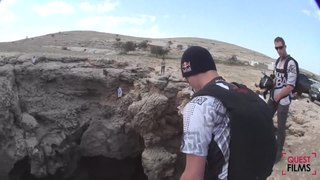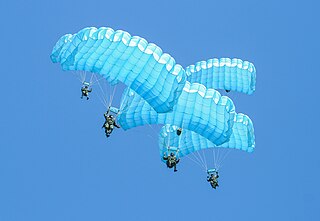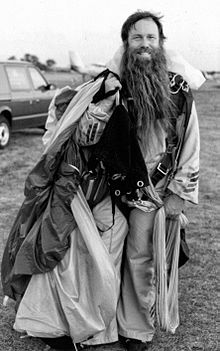
BASE jumping is the recreational sport of jumping from fixed objects, using a parachute to descend safely to the ground. "BASE" is an acronym that stands for four categories of fixed objects from which one can jump: buildings, antennas, spans (bridges), and earth (cliffs). Participants exit from a fixed object such as a cliff, and after an optional freefall delay, deploy a parachute to slow their descent and land. A popular form of BASE jumping is wingsuit BASE jumping.

A parachute is a device used to slow the motion of an object through an atmosphere by creating drag or, in a ram-air parachute, aerodynamic lift. A major application is to support people, for recreation or as a safety device for aviators, who can exit from an aircraft at height and descend safely to earth.
Skyhook, sky hook or skyhooks may refer to:

A drogue parachute, also called drag chute, is a parachute designed for deployment from a rapidly moving object. It can be used for various purposes, such as to decrease speed, to provide control and stability, as a pilot parachute to deploy a larger parachute or a combination of these. Vehicles that have used drogue parachutes include multistage parachutes, aircraft, and spacecraft recovery systems.

The 3-ring release system is a parachute component that is widely used by sport skydivers and military freefall parachutists to attach the two risers of a main parachute to the harness that bears the load under the parachute.

In skydiving, an automatic activation device (AAD) is a dead man's switch consisting of an electronic-pyrotechnic or mechanical device that automatically opens the main or reserve parachute container at a preset altitude or after a preset time.

A malfunction is a partial or total failure of a parachuting device to operate as intended. Malfunctions may require a skydiver to cut away their main parachute and deploy the reserve parachute.

A static line is a fixed cord attached to a large, stable object. It is used to open parachutes automatically for paratroopers and novice parachutists.

A pilot chute is a small auxiliary parachute used to deploy the main or reserve parachute. The pilot chute is connected by a bridle to the deployment bag containing the parachute. Pilot chutes are a critical component of all modern skydiving and BASE jumping gear. Pilot chutes are also used as a component of spacecraft such as NASA's Orion.
Cut-away is a skydiving term referring to disconnecting the main parachute from the harness-container in case of a malfunction in preparation for opening the reserve parachute. The 3-ring release system on parachutes allows a rapid cut-away in the event of an emergency.

A reserve static line, occasionally called a Stevens Lanyard or Stevens Release, is a device that automatically opens the reserve parachute container when the main parachute is cut-away. The RSL is a lanyard connecting one or both of the main parachute risers to the reserve ripcord.
In the United States, skydiving is a self-regulated sport, which means skydivers, in the US, voluntarily follow a set of basic safety requirements established by the U.S. Parachute Association. Federal requirements can be found in the Federal Aviation Regulations. Most of the regulations concern the aircraft, pilot and rules of flight. However, 14 CFR Part 105, "Parachute Operations" regulates when and where jumps may be made and designates the requirements for parachute equipment and packing. For example, 14 CFR Part 105 requires the person packing either the main chute or the reserve parachute to be a certificated rigger, which means he or she has taken an FAA-approved training course and has passed rigorous FAA testing.

Parachuting and skydiving is a method of transiting from a high point in an atmosphere to the ground or ocean surface with the aid of gravity, involving the control of speed during the descent using a parachute or parachutes.
A ripcord is a part of a skydiving harness-container system; a handle attached to a steel cable ending in a closing pin. The pin keeps the container closed and keeps the spring-loaded pilot chute inside. When the ripcord is pulled, the container is opened and the pilot chute is released, opening the parachute. On tandem systems the ripcord releases the 3-ring release system anchoring the bridle to the harness-container, allowing the parachute to open.
CharlesBroadwick was an American pioneering parachutist and inventor. An executive director of the U.S. Parachute Association, Ed Scott, said "just about all modern parachute systems" use ideas Broadwick developed: "an integrated, form-fitting harness and container system nestled on the back." Broadwick developed the static line, a line from a parachute to an aircraft that pulls the parachute from its pouch. Static lines are still used by paratroopers and novice skydivers. U.S. Army Warrant Officer Jeremiah Jones commented, "[Broadwick] is like the grandfather of paratroopers." Broadwick demonstrated parachute jumps at fairs and taught and equipped famous female parachutist Tiny Broadwick.
A closing pin is a curved piece of stainless steel metal used in the sport of skydiving. The pin is sewn onto the bridle, which is a 7- to 10-foot-long piece of nylon webbing connected to the pilot chute. The closing pin passes through the closing loop and in doing so, secures the main container of a skydiving rig, keeping the parachute from deploying prematurely. When the pilot chute is thrown out by the skydiver and catches air, it pulls the closing pin from the closing loop and allows the main parachute to be released from the container and inflate.
H. Truesdell Smith—known variously as "H. T. Smith", "Henry Truesdell Smith", "Harold Truesdell Smith", or "Daredevil Smitty" but best known as "Smitty the Jumper"—was an American exhibition parachutist and skydiver of the 1920s and 1930s. He made periodic returns to skydiving starting in the late 1950s, jumping in every subsequent decade until his death, becoming widely known as "the oldest living skydiver", a title he claimed until his death in 1995 at the age of 96.
Firebird USA LLC is an American parachute manufacturer based in Eloy, Arizona. The company also has locations in Germany, Sri Lanka, and the Czech Republic, and was formerly based in Füssen and Bitburg, Germany. The company specializes in the design and manufacture of parachutes and at one time also constructed paragliders and parafoil kites.
Luke Aikins is an American professional skydiver, BASE jumper, pilot, and aerial photographer. He is the first person to intentionally dive from mid-tropospheric altitude and land safely without a parachute or a wingsuit and the second skydiver to intentionally jump and safely land without using a parachute.
A main assisted reserve deployment (MARD) system is a skydiving safety device for parachute systems. While there are many variations, the operation and intended outcome for each is the same: open the reserve parachute container and extract the reserve parachute's deployment bag using the jettisoned main canopy. A MARD builds upon how a reserve static line (RSL) safety device works and in most circumstances, MARDs incorporate an RSL.










